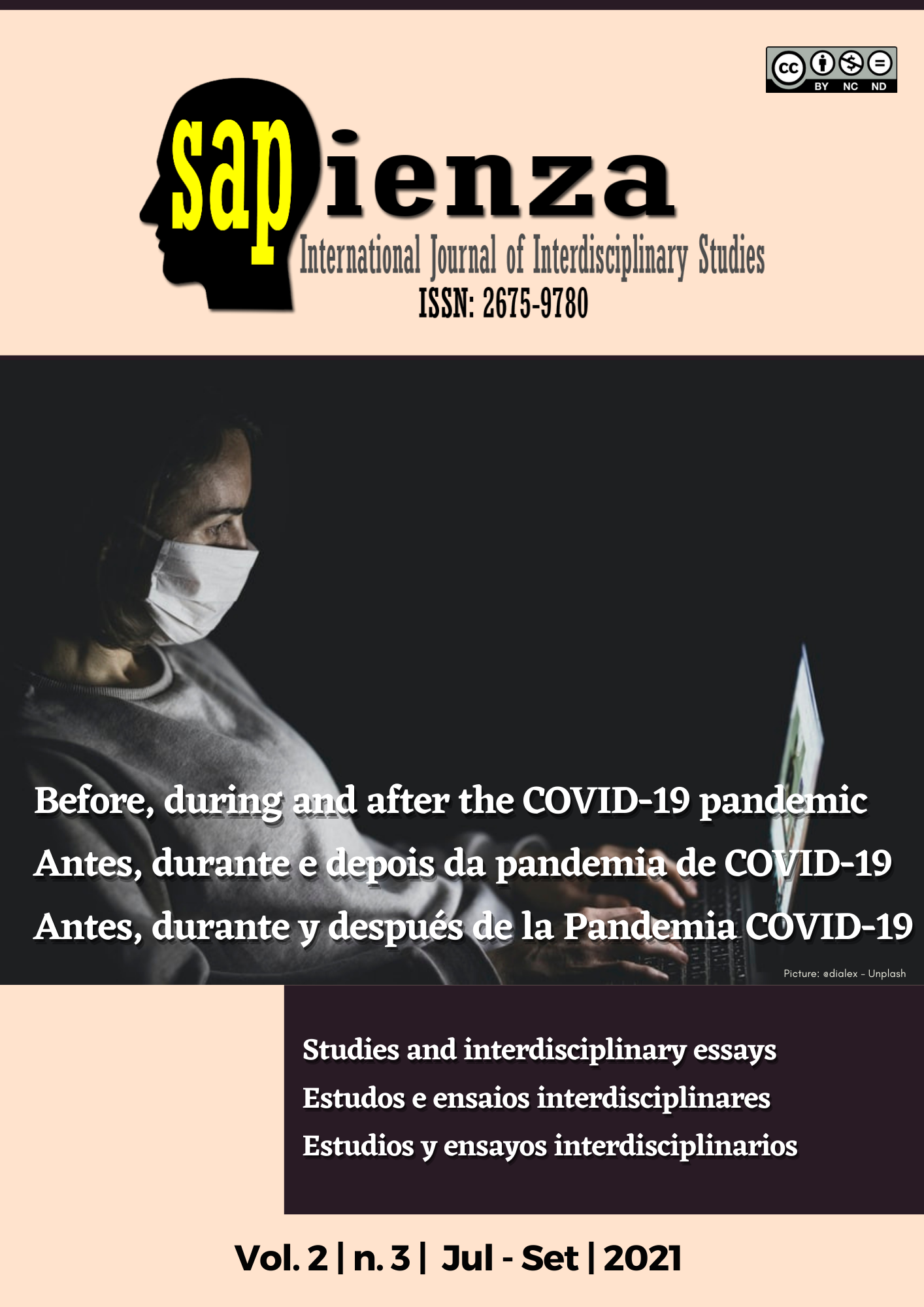The darker side of the pandemic in Perú
violence against women, children and adolescents
DOI:
https://doi.org/10.51798/sijis.v2i3.116Keywords:
violence against women, family violence, violence against children and adolescents, pandemic, COVID-19.Abstract
It is well known that the global health crisis has affected the different aspects of human life: economy, education, health, among others, causing the attention of world public opinion to be focused on the effects of the Covid-19 pandemic. However, the other pandemic in the shadows, the escalation of violence against women, children and adolescents, has taken a back seat, showing alarming figures that have put on the table again the debate on whether the solution to the problem is to radicalize the legal-police type measures or whether it should be faced as a public health problem with a gender approach that allows getting to the roots of the problem that point to the dismantling of a patriarchal social structure based on power relations and domination over women and minors. The present research was carried out under a qualitative approach with a documentary review methodology of narrative type, nourished by primary and secondary sources of information. The design was a cross-sectional study conducted in the year 2020 with a non-experimental level. The objective of this work was to know the current status of the situation of violence against women, children and adolescents in Peru.
References
Banco Interamericano de Desarrollo (BID) (2020) Con los datos en la mano: ¿qué está sucediendo con la violencia doméstica durante la pandemia? Obtenido de: https://blogs.iadb.org/seguridad-ciudadana/es/con-los-datos-en-la-mano-que-esta-sucediendo-con-la-violencia-domestica-durante-la-pandemia/
Cartilla feminicidio. Portal estadístico al 31/12/2020. Obtenido de:
https://portalestadistico.pe/wp-content/uploads/2021/01/Cartilla-de-Feminicidio-Ano-2020.pdf
Comisión Económica para América Latina (CEPAL) (2020) Enfrentar la violencia contra mujeres y niñas. Informe anual. https://oig.cepal.org/sites/default/files/folleto_25_11_esp_0.pdf )
Coomeva.coop (2021) Violencia contra la mujer: una infamia desde la prehistoria hasta la actualidad. Obtenido de: http://www.coomeva.coop/publicaciones.php?id=51474
Defensoría del pueblo. Informe N° 4. Nov. 2020 ¿Qué paso con ellas en cuarentena?
Garmendia, F. (2016) Contribución al conocimiento de la historia de la violencia en el Perú. Revista Anales. Facultad de Medicina. (77). (1) p.p. 45-50. DOI: http://dx.doi.org/10.15381/anales.v77i1.11552
Gonzales, I. (10 de enero 2018). Revista Culturamas. Sin número. Entrevista a Gerda Lerner: El Origen del Patriarcado. Obtenido de: https://www.culturamas.es/2018/01/10/gerda-lerner-el-origen-del-patriarcado/)
Hawie, I. (2021) La doble pandemia: Violencia de género y Covid-19. Revista Advocatus. DOI: https://doi.org/10.26439/advocatus2021.n39.5120
Instituto Nacional de Estadística e Informática (INEI) (2020). Perú: Femicidio y violencia contra la mujer 2015-2019. Obtenido de: https://www.inei.gob.pe/media/MenuRecursivo/publicaciones_digitales/Est/Lib1793/libro.pdf
Méndez, R. (2019) La pobreza, programas sociales y tráfico ilícito de drogas en el contexto de la radicalización de la pena a los privados de libertad del e.p Andahuaylas, Apurímac, Perú, 2018. Tesis de doctorado. Universidad Nacional San Antonio Abad del Cusco
Marrón, N. (10 de noviembre 2018). Diario El Periódico. Sección: Cuaderno. La América violada: las violencias contra las mujeres en la conquista y colonización. Obtenido de: https://www.elperiodico.com/es/cuaderno/20181110/america-violada-violencias-contra-mujeres-conquista-colonizacion-7137661
Ortiz, G. (2006) La mujer en la crónica de Indias: la aclla. Universidad de Granada. Encuentro de latinoamericanistas españoles. (12:2006. Santander) p.p 1685-1699. Obtenido de: https://halshs.archives-ouvertes.fr/halshs-00104694
Pérez, A. y Soler, B. (2010) Restos de Vida, Restos de muerte. La muerte en la prehistoria. Editorial. Museo de Prehistoria de Valencia. Obtenido de: http://mupreva.org/pub/314/va
Segato, R. (2003) Las Estructuras Elementales de la violencia. Ensayos sobre géneros entre la antropología, el psicoanálisis y los derechos humanos. Ed. Universidad de Quilmes. Argentina. Obtenido de: http://mercosursocialsolidario.org/valijapedagogica/archivos/hc/1-aportes-teoricos/2.marcos-teoricos/3.libros/RitaSegato.LasEstructurasElementalesDeLaViolencia.pdf
Organización Mundial de la Salud (OMS) (2021) Violencia de Género. Marco normativo y criterios de actuación en el sector salud. Obtenido de: https://www.who.int/es/emergencies/diseases/novel-coronavirus-2019/technical-guidance
Organización de las Naciones Unidas (ONU) 1993. Asamblea General de las Naciones Unidas, Declaración sobre la Eliminación de la Violencia contra la Mujer, Resolución 48/104 del 20 de diciembre de 1993. Obtenido de: https://www.acnur.org/fileadmin/Documentos/BDL/2002/1286.pdf?file=fileadmin/Documentos/BDL/2002/1286
Organización de las Naciones Unidas. ONU MUJERES (2020) Informe anual 2019-2020. Obtenido de: https://www.unwomen.org/es/what-we-do/ending-violence-against-women/facts-and-figures
Fondo de las Naciones Unidas para la Infancia (UNICEF) /Save the Children (2020), “Children in monetary poor households and COVID-19. Obtenido de: https://www.unicef.org/media/69656/file/TechnicalNote-Children-living-in-monetary-poor-households-and-COVID-19.pdf.pdf
Oficina de las Naciones Unidas contra la Droga y el Delito (UNDOC) (2020), “Impact of the COVID-19 Pandemic on trafficking in persons”, Thematic Brief, Viena. Obtenido de: https://www.unodc.org/documents/human-trafficking/2021/The_effects_of_the_COVID-19_pandemic_on_trafficking_in_persons.pdf
Downloads
Published
How to Cite
Issue
Section
License
Copyright (c) 2021 Martiniano Reyes Olivo, Rony Mendez Soto, Noland Gallegos Cuéllar

This work is licensed under a Creative Commons Attribution-NonCommercial-NoDerivatives 4.0 International License.




